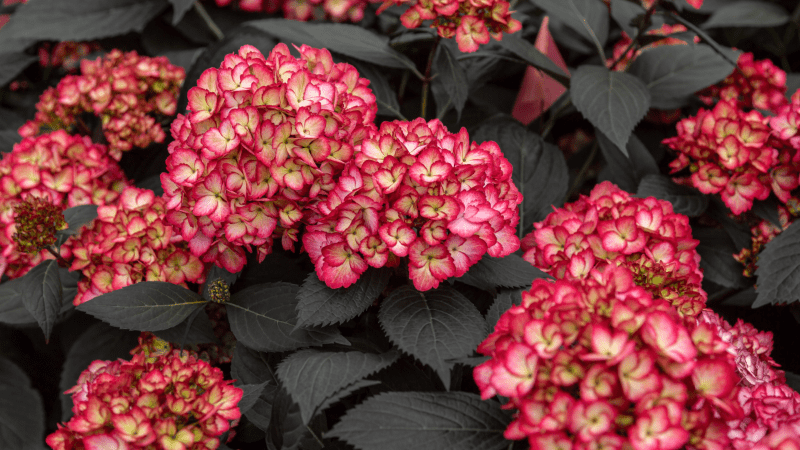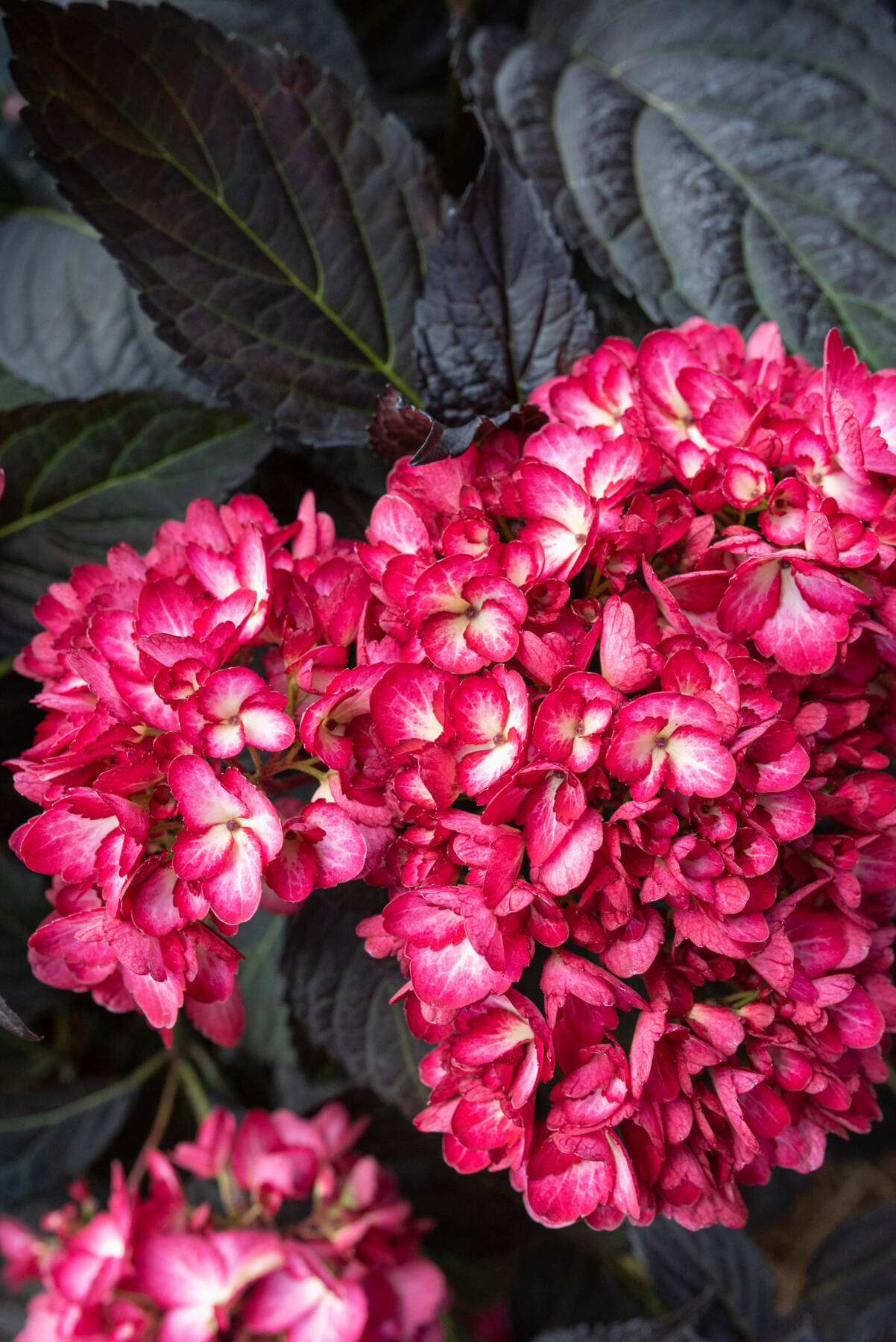
Culture Report: Hydrangea ‘Eclipse Bigleaf’
The market for Hydrangea macrophylla continues to grow with exciting innovations. ‘Eclipse Bigleaf’ hydrangea is the first Hydrangea macrophylla cultivar to retain its dark foliage all summer, even in warm climates. Consumers and the trade will love the intense dark foliage and vibrant blooms, especially in the heat of summer.
The Eclipse story begins in Georgia, at Bailey Innovations, the breeding arm of Bailey Nurseries. In 2017, David Roberts, director of plant breeding, took two hybridized plants from Hydrangea macropylla and planted the seeds to look for unique characteristics. After observing dark foliage on the seedlings, Roberts and his team continued evaluating the plants to observe their characteristics. In summer of 2018, the seedlings began to stand out as the foliage remained dark all summer.
Over the next couple years, the plants were shipped to internal and external sites around the country for production and landscape trialing. At Bailey Innovations in Georgia, these trials involved comparing Eclipse with similar dark-leaf varieties on the market. The results were clear: Eclipse had the unique ability to maintain its dark foliage, while the leaves of comparable varieties faded to green in summer. After further trialing and review, Bailey decided to introduce Eclipse to First Editions Shrubs and Trees, adding to the brand’s lineup of cultivars.
Liners and finished plants will be available to growers in spring of 2024, as Eclipse makes its first national appearance to consumers.
In production, Eclipse is low maintenance and has great disease resistance. In our production trials, Eclipse continued to produce dark foliage after a hard cutback, ensuring the plants live up to the standards of truly staying dark. Retailers have the advantage of highlighting the rich cranberry blooms that contrast beautifully against the dark leaves. These features encourage impulse sales and extend their shelf life.
Landscapers have the added benefit of mixing Eclipse with other plants in the landscape to showcase the unique contrast. At 3 to 5 feet tall and wide, Eclipse is right at home in smaller landscapes, providing brilliant form, color, and texture. Eclipse is a great fit in deco pots, where it can be grown on its own or mixed with seasonal plants. This plant does best in morning sun and afternoon shade. However, it will thrive in more sun for northern regions if adequate moisture is provided.
In addition to stunning colors, Eclipse is cold hardy and thrives in Zone 5, allowing growers to market the plants to retailers and consumers in northern regions.
MEDIA AND FERTILIZER
The media pH levels will vary by region, but we recommend a pH range of 4.5 to 6.0. EC levels should range from 0.5 to 2.7. Fertilization rates will also vary by location. In the Midwest, we incorporate Polyon 17-3-10 at 10 pounds per yard. In the Pacific Northwest, Polyon 18-6-11 is incorporated at 10 pounds per yard at planting. In Georgia, we top-dress with 18-6-18 Florikan nutricote eight to nine months at the high bag rate.
LIGHT LEVELS
In the Midwest and Pacific Northwest, Eclipse can be grown in full sun throughout the year. In southern locations, we recommend growing in a minimum of 30% shade starting April 1. Southern growers typically use 50% shade for Eclipse.
WATER
Eclipse has medium to high water requirements. However, it should be kept drier during vegetative growth. Overwatering will reduce flowering and keep the plant vegetative. Do not allow drought stress while the plants are blooming, or the flowers will burn. Acidified water should be used if needed.
PEST AND DISEASE MANAGEMENT
Eclipse is low maintenance, even in production. Growers should scout for aphids and two-spotted spider mites. Anthracnose can be an issue, but Eclipse has excellent mildew resistance. Hydrangea macrophylla is very sensitive to pre-emergent herbicides. Growers should not use the miticide Spiromesifen on hydrangeas.
PLANT GROWTH REGULATION
Daminozide, paclobutrazol and ethephon are possible options for growth regulators on Eclipse. No phytotoxicity has been observed from these PGRs at the rates used in our Minnesota greenhouse trial. Southern rates will be higher than northern rates. Do not use ethephon.
OVERWINTERING
Overwintering practices will vary by location. In Minnesota, Eclipse is overwintered using two methods. The first method involves putting the plants in a structure that is covered in dual-side black and white poly.
The second method is consolidating the plants outdoors and covering with alternating layers of 3 to 4 mm poly and 3-inch Sudan grass. With either method, temperatures are kept around 28° F.
In Illinois, the plants are consolidated into polyhouses and covered with a frost cloth. This keeps the area around the plants at or above 22° F. The frost cloth is removed in early March or when temperatures remain consistently above 50° F.
In southern regions, the plants are consolidated and covered with frost blankets when the temperatures reach 22 to 23° F. The frost blankets should be removed when temperatures exceed 50° F or irrigation is needed. Plants should be kept fully dormant to avoid winter injury.
In the Pacific Northwest, plants are spaced in growing lines outdoors. Polyhouses can be used in late winter to force early spring sales. Temperatures should be greater than 20° F.
SPECIAL NOTES
Eclipse produces many buds in fall. To increase flower count for spring shipping, avoid cutting back after mid-June. Summer cutback will force vegetative growth instead of flower buds. Avoid late season pruning.
FINISHING TIMES
Bailey offers many liner options to fit various production schedules. Bailey’s JumpStarts liners will finish in 10 to 12 weeks for #2 containers, and 16 weeks for #3 containers. Bareroot will finish in 10 to 12 weeks for #2 containers, and 12 to 16 weeks for #5 containers. Exact finishing times will vary by region.
These are general production guidelines that have worked best at Bailey’s regional facilities. Keep in mind the production practices will vary based on your specific site conditions.
For an enhanced reading experience, view this article in our digital edition by clicking here.









 Video Library
Video Library 


















